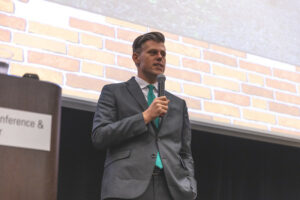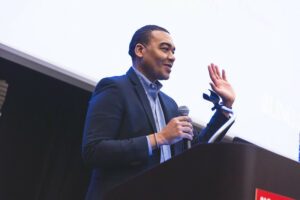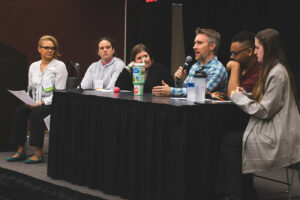The Building the Foundation Conference hosted by the Autism Society of North Carolina (ASNC) was a big success this year. More than 300 people were in attendance for this annual event held on Friday, March 8, at the McKimmon Conference and Training Center on the North Carolina State University campus in Raleigh.
Energy was high as attendees arrived from all over the state to learn more about best practices in autism. The following are some highlights from this year’s conference.

Kody Kinsley, Secretary of NC DHHS
Welcome from Kody H. Kinsley, Secretary of the North Carolina Department of Health and Human Services (DHHS)
Secretary Kinsley kicked off the conference by highlighting the importance of implementing a comprehensive approach to addressing the needs of those with individual and developmental disabilities. He noted the importance of leveraging all available state resources as well as enhancing and expanding resources by investing in direct support specialists, moving people off of waiting lists, and tailoring care management to the individual.
Evidence-Based Practices: What Works & Where We Are
Keynote speaker Brian Boyd, Ph.D. provided a valuable foundation for the day with his presentation on evidence-based practices. Dr. Boyd, the William C. Friday Professor of Education in the School of Education and Interim Director of the Frank Porter Graham (FPG) Child Development Institute at the University of North Carolina at Chapel Hill, discussed what we know about evidence-based practices (EBPs) in autism, what we do not know, who has been left out of that research, and how to move forward.

Keynote speaker Brian Boyd, Ph.D.
Citing the National Clearinghouse on Autism Evidence & Practice (NCAEP) he outlined 28 EBPs and shared EPB e-learning modules and supplemental materials from AFIRM. He emphasized that EBPs must take into consideration individual and family values and cited The Lancet Commission for the Future of Care and Clinical Research in Autism, which proposed steps “that take into account the costs, burden, and preferences of individuals or families (rather than just to the health system) and personalization on the basis of the autistic individual and families’ needs, strengths, and challenges.” Dr. Boyd continued by discussing “next steps” and the work of Air-B networking, Using Novel Implementation Tools for Evidence-Based Intervention Delivery (UNITED) strategies, implementation of interventions to improve individual self-determination, and much more. In conclusion, Dr. Boyd noted:
- The current evidence base is limited because the research has been exclusionary or overlooked certain groups.
- There is a need to partner with communities to bridge the research-to-practice gap. Implementation science and CER provide approaches for doing so.
- Moving forward, we need:
- The inclusion of more autistic individuals and other marginalized communities as coproducers of research.
- Additional information about the potential harms associated with research.
- Research across the lifespan.
Click here for Dr Boyd’s full conference presentation.
In a recent interview on WUNC’s Due South program, Dr. Boyd discussed how autism is under-researched in Black and brown communities and how we can work to change that. Listen to his interview here.
“Make It Visual!” Is Not Just a Mantra
ASNC Autism Resource Specialist Nancy Popkin provides resources to individuals, families, and professionals throughout the Charlotte area and delivers presentations and workshops to service providers, families, and other stakeholder groups. At this year’s ASNC conference, Nancy spoke about the value of visual support tools for individuals with autism and how the use of such tools helps to build self-esteem and self-confidence. She defined visual support as “a visual display that supports one in engaging in a desired behavior or skill, independent of additional prompts.” She discussed what it is that happens when we “make it visual” for those with autism spectrum disorder (ASD): we help support transitions, teach time management, lower anxiety by creating predictability, make choices less overwhelming, make the abstract concrete, etc. Nancy offered several examples of visual support tools and shared her “Hula hoop” analogy and “Train brain” metaphor to help explain how individuals with ASD process their environment. Check out Nancy’s full presentation here.
Sensory Regulation for Real Life
Cassie Fraser-Ball, MSOT, OTR/L, is an occupational therapist, currently practicing in a public-school setting with a focus on adolescents and assistive technology. Cassie has supported autistic individuals and their families for over a decade in a variety of professional roles and currently serves the ASNC Clinical Department as an occupational therapy consultant. In her presentation, Cassie first reviewed the eight sensory systems (including vestibular, proprioception, and interoception) and continued with a discussion on sensory processing. She illustrated that individuals are on a continuum that reflects how much sensory input they need to perceive and that individuals are also on a continuum as to how passively or actively they respond to sensory inputs. Using these continua, she outlined four sensory profiles noting that an individual’s sensory profile may change in different contexts or environments. She went on to clarify the difference between a sensory need and a sensory strategy and provided examples of sensory regulating strategies. Using her own family, Cassie showed how sensory experience is interconnected, explaining that we each influence a sensory environment and so we impact the sensory environment overall. Check out Cassie’s presentation for more details and helpful resources like Level UP.
Behavior: Challenging Our Assumptions
ASNC Clinical Director Whitney Sukonick, MA, LPA, BCBA and ASNC Associate Clinical Director Louise Southern, Ph.D., BCBA, LBA led this presentation designed to challenge conference-goers to think differently about behavior. Reminding listeners that not all behavior that is different requires intervention, Whitney and Louise included a review of what they believe to be common traps when assessing behavior. They emphasized the importance of considering and understanding the context for a behavior, noting that behavior is the outcome of specific circumstances. They provided a list of Guiding Questions (English and Spanish) to assist people in reframing the way they think about, assess, and address behaviors. Their presentation also provided a list of resources available through the Autism Society of North Carolina (ASNC). See Whitney’s and Louise’s full presentation here.

Conference panel of five Autistic Adults
Autistic Adult Panel
The conference ended on a high note as a panel of five autistic adults shared their perspectives on the day. Jordan Birkner, Rachel Hnatuck, Krysten H, Hunter Jervay, and Chris Voss shared their personal experiences with the best practices and resources discussed at the conference. From the use of visual support tools to developing their own unique sensory regulation strategies, the panelists illustrated how using all the tools available to them has helped them successfully navigate their lives and their world. The panel was an inspiring affirmation of all that is possible for autistic individuals.

